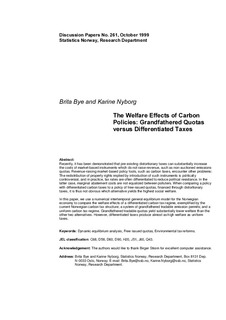The welfare effects of carbon policies: grandfathered quotas versus differentiated taxes
Working paper

Åpne
Permanent lenke
http://hdl.handle.net/11250/180935Utgivelsesdato
1999Metadata
Vis full innførselSamlinger
- Discussion Papers [1003]
Sammendrag
Recently, it has been demonstrated that pre-existing distortionary taxes can substantially increase the costs of market-based instruments which do not raise revenue, such as non-auctioned emissions quotas. Revenue-raising market-based policy tools, such as carbon taxes, encounter other problems: The redistribution of property rights implied by introduction of such instruments is politically controversial, and in practice, tax rates are often differentiated to reduce political resistance. In the latter case, marginal abatement costs are not equalized between polluters. When comparing a policy with differentiated carbon taxes to a policy of free-issued quotas, financed through distortionary taxes, it is thus not obvious which alternative yields the highest social welfare. In this paper, we use a numerical intertemporal general equilibrium model for the Norwegian economy to compare the welfare effects of a differentiated carbon tax regime, exemplified by the current Norwegian carbon tax structure; a system of grandfathered tradable emission permits; and a uniform carbon tax regime. Grandfathered tradable quotas yield substantially lower welfare than the other two alternatives. However, differentiated taxes produce almost as high welfare as uniform taxes.
Keywords: Dynamic equilibrium analysis, Free issued quotas, Environmental tax reforms.
Utgiver
Statistics Norway, Research DepartmentSerie
Discussion Papers;No. 261Beslektede innførsler
Viser innførsler beslektet ved tittel, forfatter og emneord.
-
The impacts of alternative policy instruments on environmental performance. A firm level study of temporary and persistent effects
Bye, Brita; Klemetsen, Marit Elisabeth (Discussion papers;788, Working paper, 2014-10)We study the effects of various environmental regulations on environmental performance measured as emission intensity. Moreover, we aim to test whether any such effects are persistent or only temporary. Conventional theory ... -
Labour market rigidities and environmental tax reforms : welfare effects of different regimes
Bye, Brita (Discussion Papers;No. 242, Working paper, 1998)The working of the labour market is important for the total welfare effects of tax reforms. This paper analyses, by using a computable general equilibrium model for the Norwegian economy, how different assumptions about ... -
Consequences of the IPPC-directive’s BAT requirements for abatement costs and emissions
Larsson, Jan; Telle, Kjetil (Discussion Papers;No. 411, Working paper, 2005)Abstract: The Integration Pollution and Prevention Control (IPPC) directive from the European Union implies that the regulatory emission caps should be set in accordance with each industry’s Best Available Techniques ...